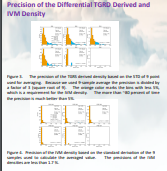Inter-calibration of Ionospheric Density data from IVM and TGRS
Qian
Wu
COSMIC/UCP UCAR
Poster
COSMIC-2 has multiple space weather instruments for ionospheric measurements. The IVM (Ion Velocity Meter) instrument measures in-situ electron densities. The TRGS (Tri-GNSS Radio Occultation System) instrument measures slant TEC, which can be used to derive electron density profiles. There have been comparisons of these two types of measurements, which were done indirectly. Since COSMIC-2 has 6 satellites and each has an IVM instrument, validating all six instruments for consistency will be invaluable for future studies of global scale structures in the ionosphere arising from tides and planetary waves. IVM observations have traditionally been validated with ground based incoherent scatter radar observations; however, the in-situ electron density can be derived from TGRS slant TEC observations providing an additional validation data source. The in-situ electron density can be derived from the TGRS slant TEC data when the observational geometry is such that the GNSS-to-LEO ray-path is aligned with the COSMIC-2 satellite velocity in the forward or backward directions. As the COSMIC-2 satellite moves, the distance between the GNSS and COSMIC-2 LEO satellite changes resulting in variations in the slant TEC. By taking the ratio between the change in the slant TEC and the distance travelled by the LEO satellite, the in-situ electron density can be derived. As a specific geometry is required, we expect to be able to derive the in-situ electron density from the TGRS observations for about 5 cases per day for each LEO satellite. That is better than the numbers of satellite overpass of a ground-based radar station. Since both instruments are continuously operating, we have more coincidences. Furthermore, there is no spatial separation between the two observations. We compared the IVM density values with the TGRS derived in-situ densities for all 6 COSMIC-2 LEO satellites.

Poster PDF